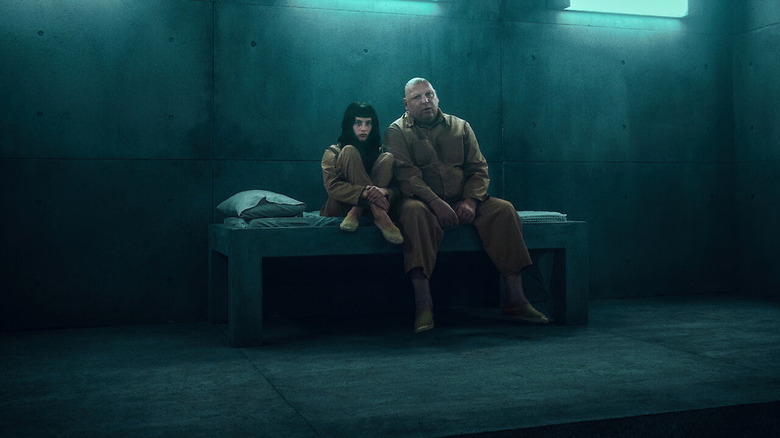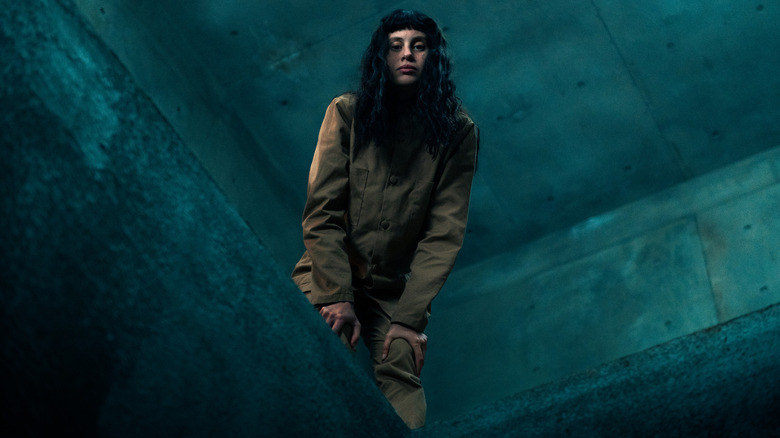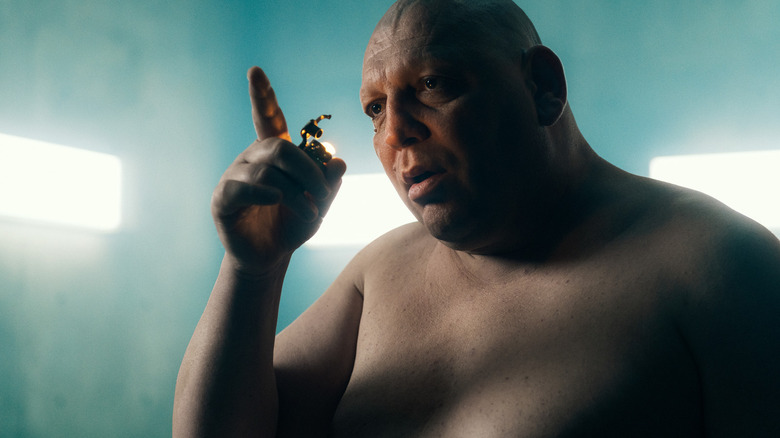The Platform 2 Ending Explained: The Return Of Some Familiar Faces
Warning: this article contains spoilers for "The Platform 2"
Galder Gaztelu-Urrutia's "The Platform 2" debuted on Netflix on Friday, October 4, and it was a slight improvement over the original. Frustratingly, "The Platform 2" didn't do much to expand on the mythology of the original film, or extend outside the same prison where the first "Platform" takes place, merely telling a very similar story in a slightly more dynamic way. To reiterate the premise: "The Platform 2" takes place in a futuristic, tower-like prison with one cell occupying each floor. There is a table-sized hole in the middle of the floor in every cell, and every day, an antigravity platform festooned with food lowers from the top of the prison all the way down to the bottom.
Prisoners at the top can eat whatever they like, while down below, they have to feast on table scraps. By the time the platform has passed a few hundred floors, the prisoners are starving and/or resorting to cannibalism. It's a pretty handy metaphor for class and poor resource allocation.
"The Platform 2" follows a woman named Perempuan (Milena Smit) as she acclimatizes to the bizarre prison, encountering a strict self-enforced code of conduct among the other prisoners. Thanks to actions witnessed in the last film, the prisoners are now careful to only eat small amounts of food, assuring everyone is fed. Those who follow the rules present them with a powerful, religious-like fervor. Those who don't give a damn, meanwhile, are happy to eat what they want and let others starve. The two groups will eventually become factions, and start fighting and murdering each other in vicious riots.
The ending of "The Platform 2," however is a little baffling, and makes us question the timeline of events. Notably, Trimagasi (Zorion Eguileor), the cellmate of the lead character from the previous film, appears to join the climax. He mentions that he just arrived, whereas in the first "Platform," he had already been there for almost a year. The big twist: "The Platform 2" is a prequel, not a sequel, to "The Platform."
Surprise! It's a prequel
To explain some of the events of "The Platform 2" in closer detail: partway through the film, Perempuan is paired with a new cellmate (Natalia Tena) who thinks she can escape the prison. Once a month, you see, prisoners are put to sleep with gas, and reshuffled in the tower, placed on new levels in the hierarchy. The Tena character thinks she recognizes the gas the prison uses, understanding that one can filter it easily enough out of their lungs with cloth.
The goal, then, is to instigate a battle where many will be killed, and then hide among the corpses, hoping to be carted out. In an extended sequence, Perempuan does just that, taking the newly arrived Trimagasi on a Platform ride. She gathers an army, and, naturally, a fatal fight breaks out, leaving everyone dead. It's very long and brutal. As the last few prisoners bleed out, Perempuan swallows a wad of cloth, which seems to be able to block the gases from entering her lungs. She lays still with the corpses.
She stays partially awake, and witnesses a bizarre cadre of guards in hazmat suits cleaning up all the dead bodies. Bafflingly, there is no gravity in the prison during cleanup, implying that they may be in space (?). She is taken down to the very bottom of the prison, cell #333, where she sees a young child in a vast, blackened space. It's hard to tell if this is a dream sequence, as Perempuan earlier told a story about how she went to prison because she was indirectly responsible for the death of a child; the kid tripped and fell into a pointy, bladed sculpture she had made. Regardless, she enters the vast, dark room to rescue the child.
But that's not the end, as there are several startling twists that play over the film's credits.
The afterlife
At first, one might assume that the clips played over the credits are mere flashbacks to the first "Platform," showing an emotional, philosophical connection to the first film. The suffering is constant, you see. But then, there's a scene wherein Perempuan calls out, and Goreng (Ivan Massagué), the protagonist from the first film — whom we assumed to be dead — reacts to her. The two then hug. It's not made explicit, but it's safe to assume that Goreng was Perempuan's boyfriend back when she accidentally killed that kid.
There's also a strange, perhaps-supernatural implication in all this. Perempuan thwacks her head as she descends into the pit at the bottom of the prison. She is told by one of the denizens of the dark that the child she rescued can be lifted up, but that she has to remain below. She finds that other characters, who had previously died in "The Platform 2" are also down there in the dark. Was "The Platform 2" a prequel, or does time get jumbled up after you're dead? This, it seems, is the afterlife. Perempuan died, but was able to save the soul of the child she killed. She has to remain dead/in Hell, but she was able to give the child new life.
New life? Perhaps. Throughout "The Platform 2," there are shots of many young kids playing on a playground in a nebulous nether-space. Each time the filmmakers cut back, the kids are climbing over each other to reach a glowing aperture in the ceiling. At the top, they are hoisted through by two adults ... and placed in cell #333. One might interpret the kids as pre-born souls. They're being hoisted into the world of the living.
Of course, if the prison in "The Platform" is a metaphor for the human soul, and not for the governmental misallocation of resources, then we might need to write some more complicated theological essays about it going forward.


